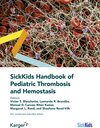
×
![Buchcover ISBN 9783318072723]()
SickKids Handbook of Pediatric Thrombosis and Hemostasis
herausgegeben von Victor S. Blanchette und weiterenThis Handbook takes the reader through the entire field of pediatric thrombosis and hemostasis and has been updated since the 2nd edition with considerable new information and elements missing in previous editions. The Handbook begins with an overview of the history of pediatric thrombosis and hemostasis, followed by a concise explanation of the complex pathophysiology of thrombosis and hemostasis. It follows with chapters focused on disorders of hemostasis in children from neonates to adolescents. Subsequent chapters are focused on thrombotic complications in children together with workup and management of thrombophilias in children. New chapters on bleeding in the adolescent girl and on management of children on mechanical circulatory support (ECMO/VAD) have been added. There is also a new chapter focused on hemostatic and thrombotic challenges in children with vascular anomalies, as pediatric hemostasis and thrombosis clinicians are increasingly being asked to manage children with these conditions. This updated Handbook is intended for health care professionals involved in the assessment and care of children with inherited and acquired bleeding and thrombotic disorders to inform and facilitate diagnostic/treatment decisions. This includes general and specialist pediatricians, in particular intensivists, neonatologists, cardiologists/cardiac surgeons, rheumatologists, nephrologists, and hematologists/oncologists, as well as medical trainees, residents, fellows, nurses, nurse practitioners, physician assistants, and pharmacists.



